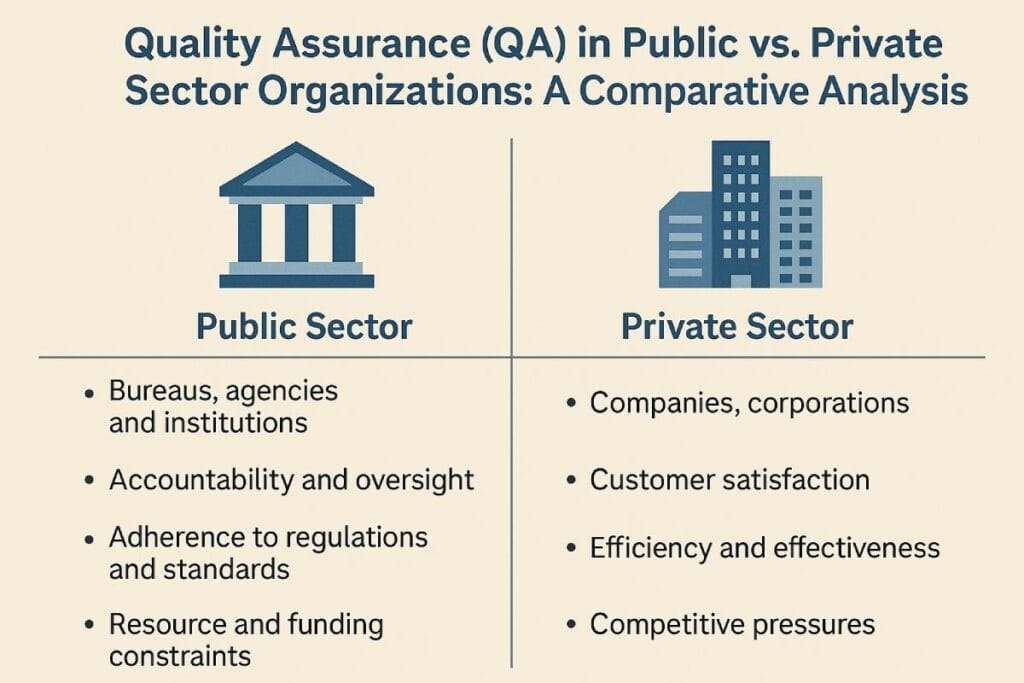Quality Assurance (QA) in Public vs. Private Sector Organizations: A Comparative Analysis

Introduction
Quality Assurance (QA) is a vital component in both public and private organizations, aiming to ensure products and services meet established standards. However, the approach, priorities, and execution of QA vary significantly between government (public) and private entities due to differences in structure, objectives, funding, and accountability mechanisms. This article explores the fundamental differences in QA practices across the two sectors and their implications on service delivery and organizational performance.
Strategic Objectives and Accountability
Public Sector:
In government institutions, QA primarily serves to uphold transparency, public trust, and regulatory compliance. The emphasis is on accountability to citizens and stakeholders, often driven by laws, audits, and external oversight. Quality initiatives are generally risk-averse and slow to change, prioritizing procedural correctness over innovation.
Private Sector:
In contrast, private companies prioritize customer satisfaction, profitability, and market competitiveness. QA is closely aligned with business goals, such as reducing operational costs, accelerating time-to-market, and improving customer retention. Private sector QA teams are more empowered to adopt agile practices, continuous improvement (Kaizen), and innovation to gain a competitive edge.
Processes and Methodologies
Public Sector:
Government agencies often follow traditional, bureaucratic QA frameworks such as ISO 9001, ITIL, or government-mandated standards. These systems emphasize documentation, standard operating procedures, and formal approvals, sometimes at the expense of flexibility. Waterfall methodologies are common, and the change approval process can be lengthy.
Private Sector:
Private organizations are more likely to implement modern QA methodologies like Agile, DevOps, Six Sigma, and TQM (Total Quality Management). They focus on speed, adaptability, and real-time feedback, using automated testing, CI/CD pipelines, and customer feedback loops to ensure rapid quality assurance and deployment cycles.
Culture and Workforce
Public Sector:
QA roles in the public sector are often structured within a hierarchical framework, with limited autonomy. Employees are typically civil servants, and performance metrics may emphasize compliance over innovation. Training is standardized, and hiring is subject to rigid qualification and vetting procedures.
Private Sector:
Private QA teams usually operate in more dynamic and merit-based environments. There’s greater freedom to innovate, experiment, and adopt new tools and practices. Performance is measured by efficiency, creativity, and ROI. Continuous training, cross-functional teams, and lateral career movement are more common.
Tools, Technology, and Budget
Public Sector:
Due to budget constraints and lengthy procurement processes, public organizations may lag behind in adopting modern QA tools. Legacy systems are common, and QA teams often face challenges integrating with newer technologies. However, some large government bodies (e.g., in defense or healthcare) do have access to advanced technologies and high compliance standards.
Private Sector:
The private sector benefits from faster technology adoption and greater investment in QA tools, ranging from automated testing suites to AI-based quality monitoring systems. This enables faster releases, better scalability, and a proactive approach to issue detection and resolution.
Risk Management and Decision-Making
Public Sector:
Public QA emphasizes risk avoidance and adherence to regulations, even if it slows innovation. Decision-making is conservative, requiring approvals through multiple administrative layers. The impact of QA failures is political or reputational, affecting public trust and legitimacy.
Private Sector:
While still concerned with risk, private firms are more open to calculated risks if they can yield innovation or profit. QA decisions are often data-driven and made rapidly by empowered teams. Failure is treated as a learning opportunity, with a fail-fast and fix-fast culture in many tech-driven organizations.
Conclusion
While both public and private sectors recognize the importance of QA, their approaches diverge due to differing priorities, operational constraints, and stakeholder expectations. The public sector emphasizes regulatory compliance, stability, and public accountability, often at the expense of speed and innovation. The private sector, in contrast, embraces agility, customer-centricity, and rapid feedback loops to enhance quality and performance.
Understanding these distinctions is crucial for QA professionals working across sectors, policymakers designing quality frameworks, and consultants aiming to bridge best practices between them. As digital transformation accelerates in both domains, a hybrid approach that combines compliance rigor with agile innovation may offer the best path forward.
Source : Medium.com




